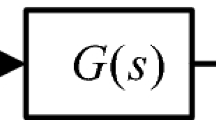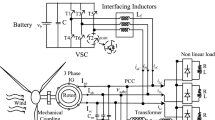Abstract
This paper proposes an online identification and compensation scheme for a distorted waveform’s harmonic and interharmonic content in electrical circuits. The proposed novel identification scheme allows the simultaneous estimation of the harmonic components’ frequency, amplitude, and phase. One of the main characteristics of the proposed online identification scheme is how the harmonics and interharmonics are estimated using a fast-convergent state estimator based on the state-space representation of the harmonic content. The proposed estimator has a decentralized approach that relies on efficient implementation, a relevant result for real-time feedback control applications, such as power conditioners control. The decentralized structure allows, if needed, selective harmonic suppression. The paper exposes a case study of identifying and suppressing the harmonic and interharmonic content produced by a three-phase load connected to the electrical power grid to demonstrate the proposed estimator’s efficiency. Hardware-in-the-loop and simulation results validate the identifier effectiveness to determine in real time the harmonic content and how it can be used to reduce the total harmonic distortion through a nonlinear optimal tracking control scheme.














Similar content being viewed by others
References
Arrillaga J, Watson N (2004) Power systems harmonics. Wiley, Chichester
IEEE Recommended Practices and Requirements for Harmonic Control in Electrical Power Systems (1993) IEEE Std 519-1992
I.E. Commission (1998) IEC 61000-3-2-electromagnetic compatibility (EMC)-part 3-2: limits-limits for harmonic current emissions
Rasol Jannesar M, Sedighi A, Savaghebi M, Anvari-Mogjaddam A, Guerrero J (2019) Optimal probabilistic planning of passive harmonic filters in distribution networks with high penetration of photovoltaic generation. Electr Power Energy Syst 110:332–348
Wang B, Shang J, Dai N, Chen H (2015) Harmonic reference currents balancing method for delta-connected static synchronous compensator. Electron Lett 51(25):2134–2136
Williams SM, Hoft RG (1991) Adaptive frequency domain control of PWM switched power line conditioner. IEEE Trans Power Electron 6(4):665–670
Yeetum W, Kinnares V (2019) Parallel active power filter based on source current detection for antiparallel resonance with robustness to parameter variations in power systems. IEEE Trans Ind Electron 66(2):876–886
Yang K, Bollen MHJ, Larsson EOA (2015) Aggregation and amplification of wind-turbine harmonic emission in a wind park. IEEE Trans Power Deliv 30(2):791–799
Khan A, Memon S, Sattar TP (2018) Analyzing integrated renewable energy and smart-grid systems to improve voltage quality and harmonic distortion losses at electric-vehicle charging stations. IEEE Access 6:26404–26415
Hwang JK, Liu Y (2014) Noise analysis of power system frequency estimated from angle difference of discrete Fourier transform coefficient. IEEE Trans Power Deliv 29(4):1533–1541
Tanaka T, Akagi H (1995) A new method of harmonic power detection based on the instantaneous active power in three-phase circuits. IEEE Trans Power Deliv 10(4):1737–1742
Radulović M, Zečević Z, Krstajić B (2020) Dynamic phasor estimation by symmetric Taylor weighted least square filter. IEEE Trans Power Deliv 35(2):828–836
Karimi-Ghartemani M, Khajehoddin SA, Jain PK, Bakhshai A, Mojiri M (2012) Addressing DC component in PLL and notch filter algorithms. IEEE Trans Power Electron 27(1):78–86
Fedele G, Ferrise A (2014) A frequency-locked-loop filter for biased multi-sinusoidal estimation. IEEE Trans Signal Process 62(5):1125–1134
Chen B, Pin G, Ng WM, Li P, Parisini T, Hui S-YR (2018) Online detection of fundamental and interharmonics in ac mains for parallel operation of multiple grid-connected power converters. IEEE Trans Power Electron 33(11):9318–9330
Hajimolahoseini H, Taban MR, Abutalebi HR (2008) Improvement of extended Kalman filter frequency tracker for nonstationary harmonic signals. In: 2008 international symposium on telecommunications, pp 592–597
Carnevale D, Astolfi A (2011) A hybrid observer for frequency estimation of saturated multi-frequency signals. In: 2011 50th IEEE conference on decision and control and European control conference, pp 2577–2582
Karimi-Ghartemani M, Ziarani AK (2004) A nonlinear time–frequency analysis method. IEEE Trans Signal Process 52(6):1585–1595
Mojiri M, Karimi-Ghartemani M, Bakhshai A (2010) Processing of harmonics and interharmonics using an adaptive notch filter. IEEE Trans Power Deliv 25(2):534–542
Ornelas-Tellez F, Rico-Melgoza JJ, Morfin-Magana R, Ramos-Paz S (2019) Optimal dynamic harmonic extraction and suppression in power conditioning applications. IEEE Trans Ind Electron 1–12
Chen Y, Fei J (2019) Dynamic sliding mode control of active power filter with integral switching gain. IEEE Access 7:21635–21644
Rameshkunar K, Indragandhi V, Arunkumari T (2017) Model predictive current control of single phase shunt active power filter. Energy Procedia 117:658–665
Madtharad C, Premrudeepreechacharn S (2002) Active power filter for three-phase four-wire electric systems using neural networks. Electric Power Syst Res 60:179–192
Kirk D (2004) Optimal control theory an introduction. Dover, Upper Saddle River
Sepulchre R (1997) Constructive nonlinear control. Springer, London
Freeman R (1996) Robust nonlinear control design: state-space and Lyapunov techniques. Birkhauser, Boston
Anderson B, Moore J (1990) Optimal control: linear quadratic methods. Prentice-Hall, Englewood Cliffs
Pahlevaninezhad M, Das P, Drobnik J, Moschopoulos G, Jain PK, Bakhshai A (2012) A nonlinear optimal control approach based on the control-Lyapunov function for an ac/dc converter used in electric vehicles. IEEE Trans Ind Inf 8(3):596–614
Liu K, Lü J, Lin Z (2018) Design of distributed observers in the presence of arbitrarily large communication delays. IEEE Trans Neural Netw Learn Syst 29(9):4447–4461
Grama A (2003) Introduction to parallel computing. Addison-Wesley, Harlow
Astrom KJ (2006) Introduction to stochastic control theory. Dover, Mineola
Tolstov GP (1962) Fourier series. Prentice Hall, Englewood Cliffs
Obregon-Pulido G, Castillo-Toledo B, Loukianov A (2002) A globally convergent estimator for n-frequencies. IEEE Trans Autom Control 47(5):857–863
Ghartemani M (2014) Enhanced phase-locked loop structures for power and energy applications. Wiley, Hoboken
Cloutier JR (1997) State-dependent Riccati equation techniques: an overview. In: Proceedings of the 1997 American control conference (Cat. No.97CH36041), vol 2, pp 932–9362
Cimen T (2010) Systematic and effective design of nonlinear feedback controllers via the state-dependent Riccati equation (SDRE) method. Annu Rev Control 34(1):32–51
Ornelas-Tellez F, Rico-Melgoza J, Espinosa-Juarez E, Sanchez E (2018) Robust control in dc microgrids. IEEE Trans Smart Grid 9(6):5543–5553
Ravinder K, Bansal HO (2019) Investigations on shunt active power filter in a PV-wind-FC based hybrid renewable energy system to improve power quality using hardware-in-the-loop testing platform. Electric Power Syst Res 177:105957
Tang C-Y, Chen Y-F, Chen Y-M, Chang Y-R (2015) DC-link voltage control strategy for three-phase back-to-back active power conditioners. IEEE Trans Ind Electron 62(10):6306–6316
Akagi H (2007) Instantaneous power theory and applications to power conditioning. Wiley IEEE Press, Hoboken
Jamshidi M (2014) Advance trends in soft computing: proceedings of WCSC 2013, December 16–18, San Antonio, Texas, USA. Springer, Cham
Khalil HK (2002) Nonlinear systems. Prentice Hall, Upper Saddle River
Author information
Authors and Affiliations
Corresponding author
Additional information
Publisher's Note
Springer Nature remains neutral with regard to jurisdictional claims in published maps and institutional affiliations.
Appendices
Signal state-space representation
Consider the signal (4) rewritten as
where \(\bar{\omega }_{1}=\sin {\alpha t}\) and \(\bar{\omega }_{2}= \cos {\alpha t}\). Then, by taking the corresponding time derivative, it is possible to state that \(\dot{\bar{\omega }}_{1}= \alpha \bar{\omega }_{2}\) and \(\dot{\bar{\omega }}_{2}= -\alpha \bar{\omega }_{1}\). By proposing the change of variable \(\omega _{1}=\frac{\bar{\omega }}{\alpha }\) and \(\omega _{2}= \bar{\omega }_{2}\), the dynamics of (A1) becomes
Introducing a parameter \(\lambda \) to scale the magnitude of the signal, and defining \(z_{1}= \lambda \omega _{1}\) and \(z_{2}= \omega _{2}\), one obtains
where the new variable \(z_{3}\) is included to model the angular frequency, which is considered to be constant, with initial condition \(z_{3}(0)= \alpha ^{2}\). Finally, signal (A1) can be obtained from (A3) through the output
where \(k_{1}=A \alpha \cos {\theta }\) and \(k_{2}= A \sin {\theta }\).
Estimator gains
1.1 B.1: Estimator parameter selection guidance
-
\(\lambda \) Weights the rising time, improving the tendency to the estimated variable.
-
\(\gamma \) Weights the convergence to the estimated frequency.
-
\(\xi \) A larger value improves the tendency to the estimated variable.
-
\(k_{1}\) Improves the tendency to the estimated variable. However, its value must be smaller than those selected for \(\lambda \) and \(\gamma \).
-
\(k_{2}\) Weights the amplitude of the oscillations in the estimate of the variable in a steady state.
Proof of Theorem 1
The estimator stability is based on the analysis of interconnected systems, as exposed in [42]. To this end, let us consider that the nth sub-system associated with the generation of the n-signal is described by
Then, the corresponding state estimator structure for (C5) is defined as
By defining the estimator error variables as \(e_{n1}=z_{n1}-\hat{z}_{n1}\), \(e_{n2}=z_{n2}-\hat{z}_{n2}\) and \(e_{n3}=z_{n3}-\hat{z}_{n3}\), thus \(e_n = [e_{n1}~~e_{n2}~~e_{n3}]^T\), then their corresponding time derivatives become
Therefore, the nth error dynamics becomes
Consider the candidate Lyapunov function to establish the asymptotic stability to the origin of (C10), as
From (C10a), with positive constants \(k_{n1}\) and \(k_{n2}\), it is immediate to see that \(\,e_{n1} \rightarrow 0\,\) as \(\,t \rightarrow \infty \,\), then by taking this fact in (C10b)–(C10c), the time derivative of (C11) becomes
Therefore, \(\dot{V}_n(e_n)\) is negative semidefinite, and by using the LaSalle’s theorem [42], function \(\dot{V}_n(e_n)=0\) for \(\,e_{n1} = 0\,\) and \(\,e_{n2} = 0\,\), consequently \(\dot{e}_{n2}=0\) and \(\dot{e}_{n2} = 0\), and from (C10b) one obtains \(0=-\dfrac{\hat{z}_{n1}}{\lambda _n}e_{n3}\), then the trivial solution \(e_{n3} = 0\) is fulfilled. Hence, the estimation error (C10) is asymptotically stable [42].
Recognize that (C10) can be rewritten as
Because the asymptotic stability of system (C10) has been demonstrated through (C11), it is assumed that there exists a positive definite Lyapunov function of the form \(V(e_{n})\) such that its time derivative can be represented as \(\dot{V}(e_{n})= -\eta _{n} \left\| e_{n}\right\| ^{2}\), where \(\eta _{n}\) becomes a stability degree [42], defining its amount of negativeness.
Then, the estimator stability analysis can be extended to the case when n signals (harmonics and interharmonics) are involved in a signal s(t). In this case, the interconnection terms appear in the analysis by considering that a signal \(s=\sum _{n=1}^N s_n=\sum _{n=1}^N \left( \frac{k_{n1}}{\lambda _{n}}z_{n1}+k_{n2} z_{n2}\right) \). Particularly, for the error \(e_1\) one obtains the interconnection described as
where
Notice that system (C14) can be rewritten into a compact form as
where
with \(e_1=[e_{11} \,\,\,e_{12} \,\,\,e_{13}]^T\) and \(e=[e_{11} \,\,\,e_{12}\,\,\,e_{13}\,\,\,\ e_{21} \,\,\,e_{22}\,\,\,e_{23} \,\,\,\ldots \,\,\,\ e_{n1} \,\,\,e_{n2}\,\,\,e_{n3}]^T\). In a similar way, the error \(e_2\) can be analyzed, resulting in
where
Therefore, generalizing for n harmonics, one can describe the whole estimation error system as
where \(\mathcal {A}= \text {diag}\{\mathcal {A}_{1}(z_{1},\hat{z}_{1}), \mathcal {A}_{2}(z_{2},\hat{z}_{2}), \ldots , \mathcal {A}_{n}(z_{n},\hat{z}_{n}) \}\), \(\mathcal {B}=[ b_{1},b_{2},\ldots , b_{n} ]^{T}\) and \(e = [e_{1},e_{2},\ldots ,e_{n}]^{T}\). Then, it is possible to state the following general Lyapunov function
with time derivative
which can be described in terms of its nominal part (already demonstrated to be asymptotically stable through (C11)–(C12) for an n estimator, with stability degree given as \(\eta _n\)), and now with the inclusion of the interconnection part as
where \(\eta _{P}\) is the general stability degree for the nominal part. Hence, if \(\eta _{P}>2 \left\| P\right\| \left\| \mathcal {B} \right\| \implies \dot{V}(e)< 0 \), then the error motion in (C17) is asymptotically stable. \(\square \)
Rights and permissions
About this article
Cite this article
Ramos-Paz, S., Ornelas-Tellez, F. & Rico-Melgoza, J.J. Dynamic harmonics–interharmonics identification and compensation through optimal control of a power conditioning application. Electr Eng 104, 3589–3602 (2022). https://doi.org/10.1007/s00202-022-01570-z
Received:
Accepted:
Published:
Issue Date:
DOI: https://doi.org/10.1007/s00202-022-01570-z




